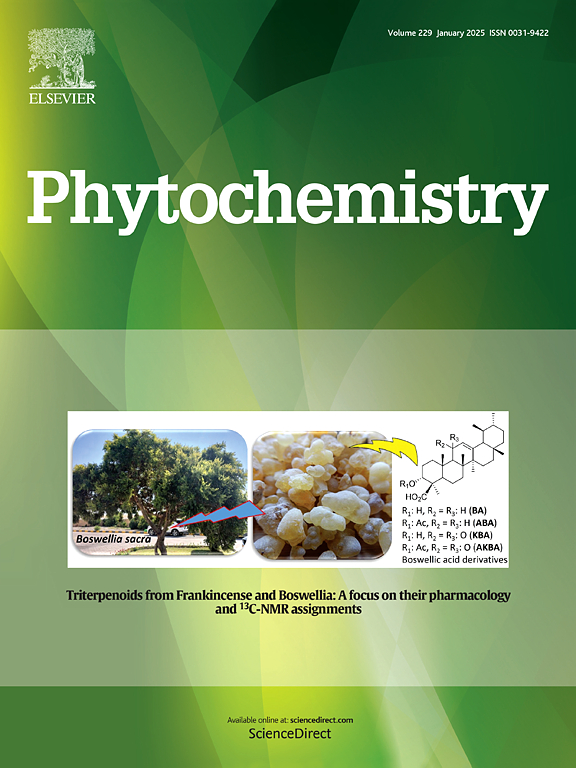UV-guided separation of polyacetylenol glycosides from the edible roots of Codonopsis pilosula and their anti-inflammatory activity
IF 3.4
2区 生物学
Q2 BIOCHEMISTRY & MOLECULAR BIOLOGY
引用次数: 0
Abstract
The UV-guided separation of polyacetylenes from the edible roots of Codonopsis pilosula resulted in the elucidation of nine previously undescribed C14-polyacetylenol glycosides, named codonopilodiynosides II-VIII (1−7) and codonopiloenynenosides C and D (8 and 9), along with sixteen known analogues (10−25). The structures of the undescribed polyacetylenes were elucidated by spectroscopic data including UV, IR, HRESIMS, NMR, modified Mosher's analysis and Mo2(OAc)4-induced ECD experiments. The inhibitory effects of the isolated compounds on lipopolysaccharide-induced nitric oxide production in RAW 264.7 cells were tested. Compounds 1, 11 and 25 exhibited better in vitro anti-inflammatory activity with IC50 values ranging from 35.49 ± 0.09 to 51.85 ± 0.11 μM than dexamethasone with IC50 value of 80.22 ± 0.24 μM. Besides, compounds 1, 11 and 25 decreased the levels of TNF-α and IL-6 in a dose-dependent manner. The results indicated the roots of C. pilosula might be developed into drugs for treating inflammation related diseases.

紫外引导下党参食用根中聚乙酰醇苷的分离及其抗炎活性研究
紫外引导下从党参可食用根中分离聚乙炔,得到了9个先前未描述的c14 -聚乙炔醇苷,分别命名为党参二苷II-VIII(1−7)和党参二烯苷C和D(8和9),以及16个已知的类似物(10−25)。通过紫外、红外、hremms、NMR、Mosher分析和Mo2(OAc)4诱导ECD实验对所描述的聚乙炔的结构进行了表征。研究了分离得到的化合物对脂多糖诱导的RAW 264.7细胞一氧化氮生成的抑制作用。化合物1、11和25的IC50值为35.49±0.09 ~ 51.85±0.11 μM,其体外抗炎活性优于地塞米松(80.22±0.24 μM)。此外,化合物1、11和25呈剂量依赖性地降低TNF-α和IL-6的水平。结果表明,党参根可开发成治疗炎症相关疾病的药物。
本文章由计算机程序翻译,如有差异,请以英文原文为准。
求助全文
约1分钟内获得全文
求助全文
来源期刊

Phytochemistry
生物-植物科学
CiteScore
6.40
自引率
7.90%
发文量
443
审稿时长
39 days
期刊介绍:
Phytochemistry is a leading international journal publishing studies of plant chemistry, biochemistry, molecular biology and genetics, structure and bioactivities of phytochemicals, including ''-omics'' and bioinformatics/computational biology approaches. Phytochemistry is a primary source for papers dealing with phytochemicals, especially reports concerning their biosynthesis, regulation, and biological properties both in planta and as bioactive principles. Articles are published online as soon as possible as Articles-in-Press and in 12 volumes per year. Occasional topic-focussed special issues are published composed of papers from invited authors.
 求助内容:
求助内容: 应助结果提醒方式:
应助结果提醒方式:


